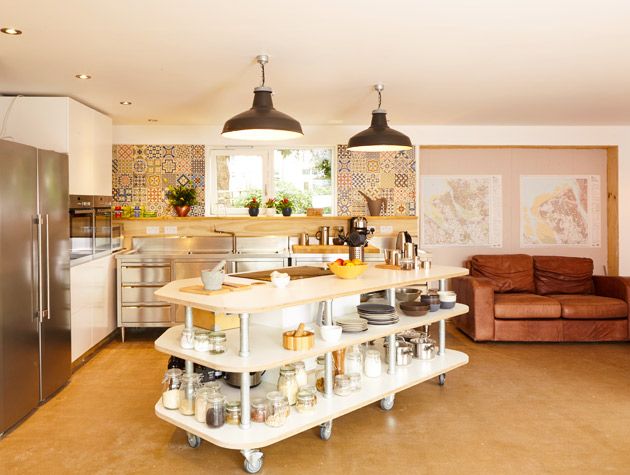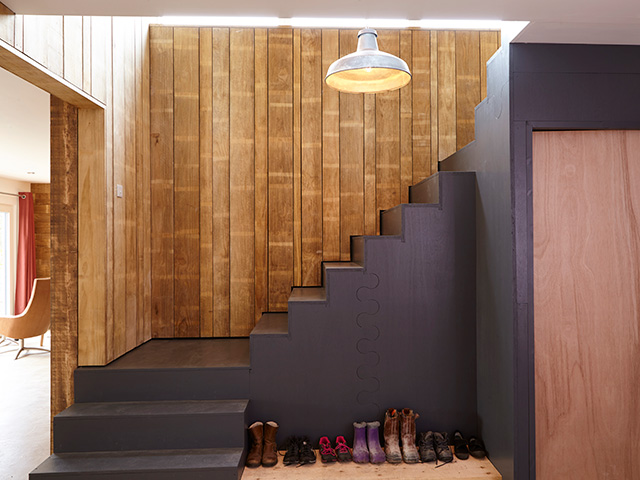Converted bungalow in Merseyside
This couple transformed a dull bungalow into their dream home, all the while living on site
Rosie and Stuart Treasurer, who appeared on Grand Designs in 2016, took the unusual approach of living on site while reimagining a bungalow in Wirral.

The house was enlarged on the first floor by extending out to the side. Photo: Joel Knight
When he was young, Stuart Treasurer remembers being obsessed with wanting to live in a converted factory or a warehouse. “In the eighties, the coolest thing in the world were those big, open Manhattan loft apartments, with hooks and cranes and concrete floors,” he says.
Stuart’s desire to live in an industrial space might go back a long way, but five years ago, the reality was a bit different: he and wife Rosie, who have children Mollie, 11, and Ben, 9, owned a sixties dormer bungalow on the Wirral in Merseyside. “It was a bit unloved, but was crying out for something to be done with it,” says Stuart. “We knew we would eventually extend it.”

A love of industrial aesthetic and the need for space inspired Rosie and Stuart to take on the project. Photo: Joel Knight
Plan of action
At first the couple’s plans were to extend the dormers and increase the floorplan of the ground floor, but as Rosie says: “It was always going to look like an extended dormer bungalow that hadn’t been done well. We took a step back and decided we needed to do the build properly.”
They hired local architect Stephen Bromilow of Bromilow Architects and came up with a more radical plan to rip out the first floor and add a new, boxed version that would appear to cantilever out towards the roadside. Kevin McCloud called it a ‘wooden wonder box’ on the TV show, and that’s as good a description as any.
Its square form and flat roof gave the couple the modern look they wanted, but it was also highly efficient, offering maximum volume with minimal cost while retaining the same ridge height as the existing house. The ‘floating’ first floor is not actually a cantilever, but a budget-friendly alternative, with slim steel supports tucked next to the perimeter wall.
A live-in project
Rosie and Stuart, on their small budget, had an unorthodox approach to doing the job properly. They wanted their build team to complete only the very basics before they moved back in and finished it off themselves – including insulation, external cladding and all the internal work – regardless of extra time it might take. They found a builder, Graeme Mealor, who was sympathetic to their ethos, and work began.
Despite the modernity of the house’s design, the planning process went smoothly, with no local objections. Stuart and Rosie had gone out of their way to let their neighbours know exactly what would be happening, but there were some rumblings of discontent as the build progressed.
The couple realised that it wasn’t the design that was an issue for the families nearby, but that the scruffiness and inconvenience of the building site, as it was so visible and close to the road.

A patchwork of glazed porcelain wall tiles add colour to the kitchen area. Photo: Joel Knight
Outer beauty
To resolve this, they accelerated their plans to finish the exterior, so that neighbours would be looking at finished cladding and render rather than bare concrete. ‘Our initial approach was to get the contractor to build a watertight shell, and that was it. We were going to do everything else ourselves to save costs, even if it took two, three, four years.’ says Stuart.
‘We were okay with it looking like a building site. We had spent so much time worrying about what the neighbours would think about the finishing details when some of them just wanted us to get the skips off the road.’
The house is finished in cladding made from Accoya, a treated softwood, and a cork-based spray-on render. A sedum roof gently softens the right angles. In line with Stuart and Rosie’s taste for something a little more rough and industrial (and to save money) they specified the cladding unfinished.
Inside, although the couple started out wanting a no-frills aesthetic of exposed roof joists and bare blockwork, they eventually opted for a more nuanced version of the industrial look, with plastered walls downstairs and the Accoya cladding used extensively on the interior walls, to give the house an almost barn-like appearance.
Downstairs, the front door opens on to a hallway, with an office to one side and a view through to the kitchen-diner straight ahead; the living space feeds off to the right, with big picture windows overlooking the garden. Upstairs, there are five bedrooms, three of them en suite.

Stuart’s love of industrial aesthetics has extended to the furniture, such as the dining table and benches. Instead of an expensive concrete floor, the screed was polished then coated with epoxy resin. Photo: Joel Knight
The interiors may be pared down but they don’t feel bare or frugal, thanks to the carefully crafted finishes. Stuart designed and made a lot of the ingenious timber joinery himself, from the CNC-routed plywood staircase to the wheeled kitchen island unit, fabricated from a sheet of melamine-coated birch plywood on a scaffold-pole base.
In a clever upcycling project, a built-in wall of shelving has been fashioned from the old roof joists. ‘I like seeing my own handiwork,’ Stuart says. ‘I’ve always enjoyed having things around me that I can keep improving and refining. For me, everything’s a prototype: for example, if I made the kitchen island again, I’d do it a bit differently.’
The couple recognise that their DIY approach was a little naïve, especially when it came to disrupting the traditional order in which works are completed. “Graeme would say to us, “how are you going to clad it?” and we’d say, “we’ll worry about it later”, but we realised you can’t always do that,” says Stuart. “For example, our choice of cladding affected how he would install the windows.
We learned that there’s a reason why one trade follows another, and if you do it in the wrong order, it starts getting expensive.” Their builder and architect could have been exasperated, but instead were sympathetic. “We were lucky,” says Rosie. “They are both lovely and it felt more like they were guiding us through it, knowing we didn’t have the knowledge. They were very patient.”

The grey painted staircase was designed and made by Stuart, using CAD and the CNC routers. Photo: Joel Knight
Now the house is finished, and not a building site, has the tide of local public opinion turned? “In the end, we had a lot of support from close neighbours – we even watched the programme with some of them when it aired,” says Rosie. “Lots of local people have told us they love the house. A stranger put a note through our door to tell us how lovely they think it is, and how great it was to see us working as a family to realise our dream. All of that reassured us that a large part of the community was positive about it.”
It may not be the warehouse conversion Stuart dreamed of as a teenager, but it’s a family-friendly compromise, much better suited to their lives. Who needs a warehouse when you can have a light, warm home with leafy views? As Kevin says, it’s ‘an extraordinary, pound-stretching, semi-industrial world.’
Architect Stephen Bromilow
Bedrooms 5
Bathrooms 5
Plot cost £337,500
Build budget £120,000









